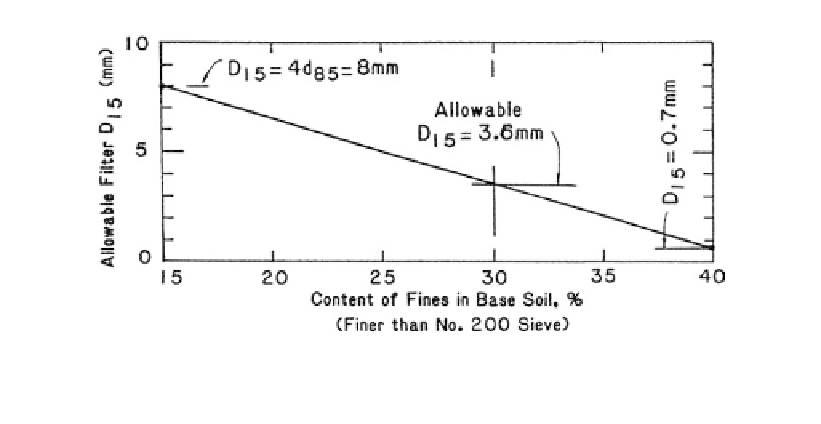Environmental Engineering Reference
In-Depth Information
Figure 9.10.
Determination of allowable D
15F
for filters for impervious Soil Group 4 (having between
15% and 40% finer than 0.075 mm sieve). (Sherard and Dunnigan, 1985, reproduced with
permission of ASCE).
3.
Impervious Soil Group 2
(sandy silts and clays and silty and clayey sands): For sandy
(and gravelly) impervious soils with 40% to 85% by weight (of the portion finer than
the 4.76 mm sieve) finer than the 0.075 mm sieve, the allowable filter for design should
have D
15F
0.7 mm;
4.
Impervious Soil Group 3
(sands and sandy gravels with small content of fines): For
silty and clayey sands and gravels with 15% or less by weight (of the portion finer than
the 4.76 mm sieve) finer than the 0.075 mm sieve the allowable filter for design should
have D
15F
4D
85B
where D
85B
can be the 85% finer size of the entire material includ-
ing gravels;
5.
Impervious Soil Group 4
: For coarse impervious soils intermediate between Groups 2
and 3 above, with 15% to 40% passing the 0.075 mm sieve, the allowable filter for
design is intermediate, inversely related linearly with the fines content and can be com-
puted by straight line interpolation. As an example (Figure 9.10) for an impervious sandy
soil with 30% of silty or clayey fines and D
85B
2 mm, the allowable filter for design is in
between the value of D
15F
0.7 mm (for soils of Group 2) and D
15F
4
(2)
8mm
(for soils of Group 3), and is calculated as follows:
40
30
D
(8
0.7)
0.7
3.6 mm
15F
40
15
6. As well as having D
15F
sizes as set out above, the filters for Soil Groups 1 and 2 must
be composed wholly of sand or gravelly sand in which
60% is coarser (that is
40%
finer) than 4.76 mm and the maximum particle size is 50 mm;
7. The above criteria can be applied for all soils in Groups 1 and 2 regardless of the shape
of the particle size distribution curve. For soils of Groups 3 and 4 the criteria apply to
reasonably well-graded soils. For soils in Groups 3 and 4 which are highly gap-graded
it is desirable to provide a filter for the finer portion of the gap-graded soil, or carry out
No Erosion Filter Tests in the laboratory to select the appropriate filter.
Sherard and Dunnigan (1985) indicate that these criteria already incorporate an ade-
quate factor of safety.
The criteria listed above do not include specific reference to limiting the “fines” con-
tent, i.e. silt and clay passing 0.075 mm sieve, except that (6) indicates filters for Soil
Groups 1 and 2 should be composed “wholly of sand and gravel”. Some limitation on


